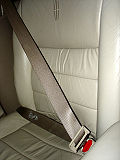Seat belt
Seat belt (also known as a safety belt) is a vehicle safety device designed to secure the driver or a passenger of a vehicle against harmful movement that may result during a collision or a sudden stop.
History
The first patent for the use of seat belts was issued to Edward J. Claghorn of New York, United States on February 10, 1885. Nils Bohlin, a Swedish inventor working for Volvo, designed the modern three-point seat belt in 1959.
Design
Seat belts are designed to retain people in their seats, and so prevent or reduce injuries suffered in a crash. They ensure that as little contact is made between the occupant and vehicle interior as possible and significantly reduce the risk in a crash.
Three-point seat belt
The three-point seat belt was developed to protect car occupants from injury in a crash, particularly in a high impact crash. The three-point seat belt is a combination of a lap belt and a sash belt, providing restraint to the upper and lower body.
Effectiveness
Seat belts are one of the most effective means of saving lives and reducing injuries in crashes. They reduce the risk of death for front seat passengers by 45% and the risk of serious injury by 50%.
Legislation
Many countries have made it mandatory for vehicle occupants to wear seat belts. The first mandatory seat belt law was put into effect in Victoria, Australia in 1970.
See also
References
Transform your life with W8MD's budget GLP-1 injections from $125.
W8MD offers a medical weight loss program to lose weight in Philadelphia. Our physician-supervised medical weight loss provides:
- Most insurances accepted or discounted self-pay rates. We will obtain insurance prior authorizations if needed.
- Generic GLP1 weight loss injections from $125 for the starting dose.
- Also offer prescription weight loss medications including Phentermine, Qsymia, Diethylpropion, Contrave etc.
NYC weight loss doctor appointments
Start your NYC weight loss journey today at our NYC medical weight loss and Philadelphia medical weight loss clinics.
- Call 718-946-5500 to lose weight in NYC or for medical weight loss in Philadelphia 215-676-2334.
- Tags:NYC medical weight loss, Philadelphia lose weight Zepbound NYC, Budget GLP1 weight loss injections, Wegovy Philadelphia, Wegovy NYC, Philadelphia medical weight loss, Brookly weight loss and Wegovy NYC
|
WikiMD's Wellness Encyclopedia |
| Let Food Be Thy Medicine Medicine Thy Food - Hippocrates |
Medical Disclaimer: WikiMD is not a substitute for professional medical advice. The information on WikiMD is provided as an information resource only, may be incorrect, outdated or misleading, and is not to be used or relied on for any diagnostic or treatment purposes. Please consult your health care provider before making any healthcare decisions or for guidance about a specific medical condition. WikiMD expressly disclaims responsibility, and shall have no liability, for any damages, loss, injury, or liability whatsoever suffered as a result of your reliance on the information contained in this site. By visiting this site you agree to the foregoing terms and conditions, which may from time to time be changed or supplemented by WikiMD. If you do not agree to the foregoing terms and conditions, you should not enter or use this site. See full disclaimer.
Credits:Most images are courtesy of Wikimedia commons, and templates, categories Wikipedia, licensed under CC BY SA or similar.
Contributors: Prab R. Tumpati, MD











